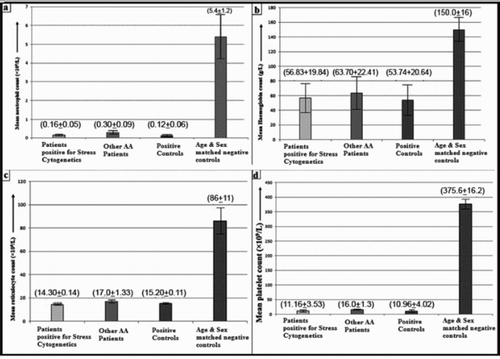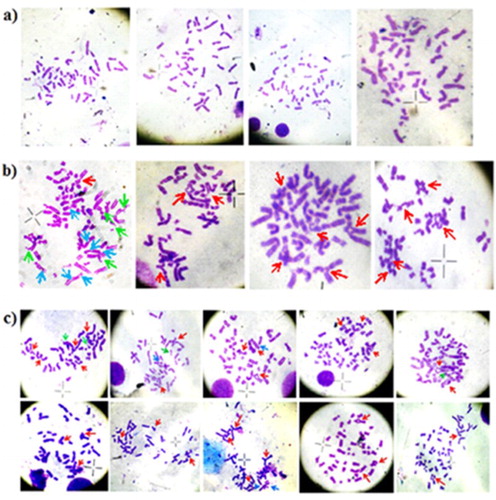Figures & data
Table 1. The typical features associated with FA and their percentage of occurrence.
Table 2. The data of clinical manifestation and family history of six stress cytogenetics positive patients.
Figure 1. The graphical representation of the mean and standard deviation of the (a) neutrophil, (b) haemoglobin, (c) reticulocyte and (d) platelet, which are responsible for pancytopenia. The data of stress cytogenetics positive cases and positive control are almost consistent with each other. The counts of other 57 AA cases, which are not sensitive to MMC are moderately higher than MMC-sensitive and positive control groups. The counts of the age- and sex-matched negative controls are significantly higher than the other three groups.

Table 3. The clinical findings and haematological profile of patients positive for stress cytogenetics, other AA patients, positive and negative controls.
Figure 2. The representative picture of the metaphases obtained from the stress cytogenetics culture; (a) metaphase cells from the negative control cases, where virtually no break or radial structure was found, (b) metaphase cell from the positive control cases, where very high number of break, radial, bi-radial, and tri-radial structures are observed, (c) metaphases from the six stress cytogenetics positive patients, having a high number of break, radial, bi-radial, and tri-radial structures like positive controls. The picture of the metaphases found from other 57 AA cases who are not positive for stress cytogenetics was like negative controls. MMC acts as a potent DNA cross-linker. Chromosome breakage and radial formation are nothing but Interstrand cross-links (ICLs). ICLs can arise in the pre and post state of DNA replication between homologous regions of sister chromatid. In case of post-replication state ICLs, there is two ways, either homologous repair between sister chromatids produce an error-free repair or mitosis proceeds normally and one of the daughter cells inherits an un-repaired ICL. In case of pre-replication state ICLs, where a homologous sister chromatid is not available for re-combinational repair, the mechanism is completed by three ways, (1) non-homologous end joining, (2) excision repair and/or lesion bypass and (3) homologous repairs between homologous chromosomes. Whereas first two mechanisms are error-prone, the third one is error-free. A mandatory-break is generated by un-repaired ICLs during mitosis. The red, green and blue arrows are indicating the radial structures, chromosomal break and gap respectively.

